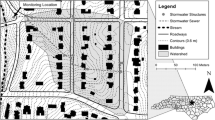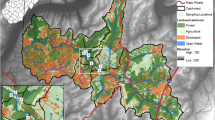Abstract
Because elevated levels of water-borne Escherichia coli in streams are a leading cause of water quality impairments in the U.S., water-quality managers need tools for predicting aqueous E. coli levels. Presently, E. coli levels may be predicted using complex mechanistic models that have a high degree of unchecked uncertainty or simpler statistical models. To assess spatio-temporal patterns of instream E. coli levels, herein we measured E. coli, a pathogen indicator, at 16 sites (at four different times) within the Squaw Creek watershed, Iowa, and subsequently, the Markov Random Field model was exploited to develop a neighborhood statistics model for predicting instream E. coli levels. Two observed covariates, local water temperature (degrees Celsius) and mean cross-sectional depth (meters), were used as inputs to the model. Predictions of E. coli levels in the water column were compared with independent observational data collected from 16 in-stream locations. The results revealed that spatio-temporal averages of predicted and observed E. coli levels were extremely close. Approximately 66 % of individual predicted E. coli concentrations were within a factor of 2 of the observed values. In only one event, the difference between prediction and observation was beyond one order of magnitude. The mean of all predicted values at 16 locations was approximately 1 % higher than the mean of the observed values. The approach presented here will be useful while assessing instream contaminations such as pathogen/pathogen indicator levels at the watershed scale.






Similar content being viewed by others
References
American Public Health Association (APHA). (1999). Standard methods for the examination of water and wastewater, AWWA, Water Environment Federation.
Bai, S., & Lung, W. S. (2005). Modeling sediment impact on the transport of fecal bacteria. Water Research, 39(20), 5232–5240.
Besag, J. (1974). Spatial integration and the statistical analysis of lattice systems. Journal of Royal Statistical Society, 36(2), 192–236.
Cho, K. H., Pachepsky, Y. A., Kim, J. H., Guber, A. K., Shelton, D. R., & Rowland, R. (2010). Release of escherichia coli from the bottom sediment in a first-order creek: experiment and reach-specific modeling. Journal of Hydrology, 391, 322–332.
Cressie, N. (1993). Statistics for spatial data. New York: John Wiley & Sons.
Dorner, S. M., Anderson, W. B., Slawson, R. M., Kouwen, N., & Huck, P. M. (2006). Hydrologic modeling of pathogen fate and transport. Environmental Science & Technology, 40(15), 4746–4753.
Droppo, I. G., Liss, S. N., Williams, D., Nelson, T., Jaskot, C., & Trapp, B. (2009). Dynamic existence of waterborne pathogens within river sediment compartments: implications for water quality regulatory affairs. Environmental Science & Technology, 43(6), 1737–1743.
Hipsey, M. R., Antenucci, J. P., & Brookes, J. D. (2008). A generic, process-based model of microbial pollution in aquatic systems. Water Resources Research, 44(7), W07408.
Iowa Environment Mesonet (IEM). (2012). Iowa AG Climate Network, Iowa State University. http://mesonet.agron.iastate.edu/agclimate/hist/hourlyRequest.php.
Jamieson, R. C., Joy, D. M., Lee, H., Kostaschuk, R., & Gordon, R. J. (2005). Resuspension of sediment-associated Escherichia coli in a natural stream. Journal of Environmental Quality, 34(2), 581–589.
Kaiser, M.S. (2010). Statistical methods for spatial data. Course lecture, Department of Statistics, Iowa State University.
Kaiser, M. S., & Nordman, D. J. (2012). Blockwise empirical likelihood for spatial Markov Model assessment. Statistics and Its Interface, 0, 1–8.
Kim, J. W., Pachepsky, Y. A., Shelton, D. R., & Coppock, C. (2010). Effect of streambed bacteria release on E. coli concentrations: monitoring and modeling with the modified SWAT. Ecological Modelling, 221(12), 1592–1604.
Muirhead, R. W., Davies-Colley, R. J., Donnison, A. M., & Nagels, J. W. (2004). Fecal bacteria yields in artificial flood events: quantifying in-stream stores. Water Research, 38, 1215–1224.
Nagels, J. W., Davies-Colley, R. J., Donnison, A. M., & Muirhead, R. W. (2002). Faecal contamination over flood events in a pastoral agricultural stream in New Zealand. Water Science and Technology, 45(12), 45–52.
Pachepsky, Y. A., & Shelton, D. R. (2011). Escherichia coli and fecal coliforms in freshwater and estuariene sedients. Critical Reviews in Environmental Science and Technology, 41(12), 1067–1111.
Pandey, P. K., Soupir, M. L., & Rehmann, C. R. (2012a). Predicting resuspension of Escherichia coli from streambed sediments. Water Research, 46, 115–126.
Pandey, P. K., Soupir, M. L., Haddad, M., & Rothwell, J. J. (2012b). Assessing the impacts of watershed indexes and precipitation on spatial in-stream E. coli concentrations. Ecological Indicator, 23, 641–652.
Parajuli, P. B., Douglas-Mankin, K. R., Barnes, P. L., & Rossi, C. G. (2009). Fecal bacteria source characterization and sensitivity analysis of SWAT 2005. Transaction of ASABE, 52(6), 1847–1858.
Rehmann, C. R., & Soupir, M. L. (2009). Importance of interactions between the water column and the sediment for microbial concentrations in streams. Water Research, 43(18), 4579–4589.
Rothwell, J. J., Dise, N. B., Taylor, K. G., Allott, T. E. H., Scholefield, P., Davies, H., & Neal, C. (2010a). A spatial and seasonal assessment of river water chemistry across North West England. Science of Total Environment, 408, 841–855.
Rothwell, J. J., Dise, N. B., Taylor, K. G., Allott, T. E. H., Scholefield, P., Davies, H., & Neal, C. (2010b). Predicting river water quality across North West England using catchment characteristics. Journal of Hydrology, 395(3–4), 153–162.
Schilling, K. E., Zhang, Y., Hill, D. R., Jones, C. S., & Wolter, C. F. (2009). Temporal variations of E. coli concentrations in a large Midwestern river. Journal of Hydrology, 365, 79–85.
U.S. Environmental Protection Agency (USEPA). (2012a). WATERS (Watershed Assessment, Tracking & Environmental ResultS). Washington, D.C. (accessed on 10/22/2012).
U.S. Environmental Protection Agency (U.S. EPA). (2012b). Recreational water quality criteria. http://water.epa.gov/scitech/swguidance/standards/criteria/health/recreation/index.cfm (accessed on 2/22/2013).
U.S. Environmental Protection Agency (USEPA). (2013). WATERS (Watershed Assessment, Tracking & Environmental ResultS). Washington, D.C. (accessed on 2/22/2013).
Wilkes, G., Edge, T. A., Gannon, V. P. J., Jokinen, C., Lyautey, E., Neumann, N. F., Ruecker, N., Scott, A., Sunohara, M., Topp, E., & Lapen, D. R. (2011). Associations among pathogenic bateria, parasites, and environmental and land use factors in multiple mixed-use watersheds. Water Research, 45(18), 5807–5825.
World Health Organization. (2010). Water sanitation and health. http://www.who.int/water_sanitation_health/diseases/en/
Acknowledgments
The authors thank the Division of Agriculture and Natural Resources (ANR) and Veterinary Medicine Extension, University of California, Davis, and National Science Foundation (award No. CBET-0967845) for supporting this work.
Author information
Authors and Affiliations
Corresponding author
Rights and permissions
About this article
Cite this article
Pandey, P.K., Pasternack, G.B., Majumder, M. et al. A neighborhood statistics model for predicting stream pathogen indicator levels. Environ Monit Assess 187, 124 (2015). https://doi.org/10.1007/s10661-014-4228-1
Received:
Accepted:
Published:
DOI: https://doi.org/10.1007/s10661-014-4228-1




